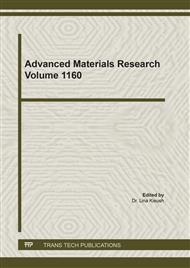[1]
F.I. Obahiagbon. A review. Aspects of the African oil palm (Elaeis guineensis jacq) and the implications of its bioactivities in human health. American Journal of Biochemistry and Molecular Biology, (2012).
DOI: 10.3923/ajbmb.2012.106.119
Google Scholar
[2]
B.V. Owoyele, and GO Owolabi. Traditional oil palm (Elaeis guineensis jacq.) and its medicinal uses: A review. TANG Humanitas Medicine. (2014). 4(3) e16.1-7.
DOI: 10.5667/tang.2014.0004
Google Scholar
[3]
C.P. Faizul, C. Abdullah and B. Fazlul. Extraction of silica from palm ash using citric acid leaching treatment: preliminary result. Advanced Materials Research. (2013). 795 (2013) 701-706.
DOI: 10.4028/www.scientific.net/amr.795.701
Google Scholar
[4]
N. Abdullah, and F. Sulaiman. The properties of the washed empty fruit bunches of the Oil Palm. Journal of Physical Science. (2013). 24 (2) 117-137.
Google Scholar
[5]
N.Z. Yusof, S.S.A. Gani, Y. Siddiqui, N.F.M. Mokhtar and Z.A.A. Hasan. Potential uses of oil palm (Elaeis guineensis) leaf extract in topical application. (2016). Journal of Oil Palm Research. 28(4): 520-530.
DOI: 10.21894/jopr.2016.2804.13
Google Scholar
[6]
Y.Y. Chun, S.A.S. Abdul Kadir, Y.P. Lim, S.N. SyedAriffin and Z. Zamzuri. An Investigation into Physicochemical Characteristics of Ash Produced from Combustion of Oil Palm Biomass Waste in A Boiler. Fuel Processing Technology. (2008). 89 (7) 693-696.
DOI: 10.1016/j.fuproc.2007.12.012
Google Scholar
[7]
M.A. Awodun, J.O. Ojeniji, A. Adeboye and S.A. Adedina. Effect of palm bunch refuse ash on soil and plant nutrient composition on yield of maize. American-Eurasian Journal of Sustainable Agriculture. (2007). 3 50-54.
Google Scholar
[8]
P.O. Eremrena and S.I. Mensah. Efficacy of palm bunch ash on the growth performance and mineral nutrient composition of Phaseolus vulgaris L grown in diesel oil-polluted soil. Journal of Applied Life Sciences International. (2017). 10 (4) 1-6.
DOI: 10.9734/jalsi/2017/31310
Google Scholar
[9]
M.A. Sulaiman, K. Muthusamy, S. Mat Aris, M.H. Mohd Rasid, R. Paramasivam and R. Othman. Effect of unground oil palm ash as mixing ingredient towards properties of concrete. IOP Conf. Series: Earth and Environmental Science. (2017). 140 (2018).
DOI: 10.1088/1755-1315/140/1/012150
Google Scholar
[10]
R. Dungani, P. Aditiawati, S. Aprilia, K. Yuniarti, T. Karliati, I. Suwandhi and I. Sumardi Biomaterial from oil palm waste: properties, characterisation and applications. IntechOpen. (2018). 31-52.
DOI: 10.5772/intechopen.76412
Google Scholar
[11]
N.H. Jamil, M.M.A. Abdulla, F.C. Pa, R.M. Zaki, M. Darus, C.M.R. Ghazalli and M.F. Nor. Potential application of palm ash as a raw material in production of green glass. Advanced Materials Research. (2012). 626 (2013) 1006-1009.
Google Scholar
[12]
A. M. Oyekanmi, O.R. Adebayo and A.G. Farombi. Physicochemical properties of African black soap and it's comparison with industrial black soap. American Journal of Chemistry. (2014). 4 (1) 35-37.
Google Scholar
[13]
J. Undiandeye, B.S. Vopnu, B.O. Evbuomwan, and K.H. Amakiri. Assessment of alkali level in palm bunch ash for black soap production. European International Journal of Science and Technology. (2015). 8 (15) 138-142.
Google Scholar
[14]
I.A. Udoetok. Characterization of ash made from oil palm empty fruits bunches (oefb). International Journal of Environmental Sciences. (2012). 3(1) 518-524.
Google Scholar
[15]
D. Johnson. Palm ash: a humble product of many uses. PALMS. (2011). 55 (3) 117-121.
Google Scholar
[16]
I.J. Udeinya. Fire retardant compositions and methods for their preparation and use. United States Patent. US 7,445732 B2. (2008). 1-5.
Google Scholar
[17]
American Public Health Association. Standard methods for the examination of water and wastewater. 16th Edition, United States of America, Baltimore, Maryland. (1985).
Google Scholar
[18]
American Public Health Association (APHA) Standard Methods for the Examination of Water and Wastewater. 19th Edition, American Public Health Association Inc., New York. (1995).
Google Scholar
[19]
American Public Health Association; American Water Works Assoc. & Water Environment Federation. Standard Methods for the Examination of Water and Wastewater (20th ed.). Baltimore, MD: American Public Health Association. (1999).
DOI: 10.1002/j.1551-8833.1932.tb18153.x
Google Scholar
[20]
EPA. (2012). 5.9 Conductivity. In Water: Monitoring and Assessment. Retrieved from http://water.epa.gov/type/rsl/monitoring/vms59.cfm. Last updated October 04 (2012).
Google Scholar
[21]
Fondriest Environmental, Inc. Conductivity, salinity and total dissolved solids. Fundamentals of environmental measurements. (2014). https://www.fondriest.com/environmental-measurements/parameters/waterquality/conductivity-salinity-tds/ Last updated January (2020).
Google Scholar
[22]
W. Gallagher. Operational Definition of Acids and Bases. In Chem 352: University of Wisconsin-Eau Claire. 2011 1-11.
Google Scholar


